It was a cold January evening. I stood in the garage, examining the tags on two sleeping bags. One sleeping bag was rated for zero-degree weather, the other for twenty-degrees. While I contemplated these options, my bare feet began to ache from the cold seeping into my toes. Hearing my phone ringing on the kitchen table, I gratefully scampered into the house, my feet tingling as they warmed.
Upon answering the phone, I heard the voice of my fishing partner, Nick, “I just talked with the campground host at Lazy L&L Campground,” he said, “The host said we won’t have any problems finding a campsite. It sounds like we’re going to be the only idiots camping this weekend. The temperature is supposed to drop into the low twenties.”
After hanging up, I went back to the garage and threw both sleeping bags into the truck. For eight years I have lived in the Lone Star State, and over that time, my Yankee blood has thinned considerably. Cold weather affects me more than it used to, but by stuffing the twenty-degree bag inside the heavier, zero-degree bag, I’d surely be as toasty as a kolache fresh from the oven.
My camping gear and fly rods were packed. Now, all I had to do was wait for the early morning when our party of three, Nick, Travis, and I, would drive west. Our destination was the nation’s southernmost trout stream, the Guadalupe River.
The Guad, as it is known locally, is a renowned trout fishery. Talk to any member of Trout Unlimited and they will likely know of it. The Guad’s reputation is due, in large part, to The Guadalupe River Chapter of Trout Unlimited (GRTU).
More Like This
GRTU boasts an impressive number of anglers. At 5,500 members, it is the largest TU chapter in the country. GRTU independently raises beautiful (and big) rainbow trout that it releases into the Guad. This independent stocking of big bows is in addition to the already robust stocking program run by Texas Parks and Wildlife Department.
Not only has GRTU been instrumental in developing the Guadalupe River as the nation’s southernmost trout fishery, but is has also lent valuable financial assistance to other cold-water fisheries throughout the west. GRTU has been involved in cutthroat restoration efforts in several states, including a study that examined the potential of restoring native Rio Grande cutthroat to McKittrick Creek in the Guadalupe Mountains in west Texas.
Every February, GRTU hosts an annual festival called Troutfest. This event usually attracts upwards of 3,000 anglers to the Guadalupe River. Notable fly fishers like Tom Rosenbauer, Flip Pallot, and Kirk Deeter, have made appearances at Troutfest.

Our trip to the Guad preceded Toutfest by a full month, but because this river is so popular, we fully expected to share the water with other anglers. This was despite our attempts to arrive on Friday, prior to the official start of the weekend.
By the time we pulled into the Lazy L&L Campground it was close to 9:00 AM. We quickly unloaded some of our camping gear and then hopped back into our vehicles and headed for the water. We pulled into the Rio Guadalupe Resort campground, and after paying the access fee, headed down the bank towards the clear waters of the Guad.
Finding river access to the Guad can be a little tricky. The only public access site is at the tailwaters of the Canyon Lake Dam. Other than that, access can be attained by paying a fee to the campgrounds that are found adjacent to the river, or by becoming a GRTU member and gaining access to the areas that are leased by them.
Due to the finite number of access areas, some sections of the Guad can be shoulder-to-shoulder with both fly and conventional anglers. It’s the definition of “combat fishing.” Thankfully, anglers who are willing to put forth some effort, can walk (or paddle), and escape the crowds. Due to lenient Texas River Law, once anglers are in the water, they have the opportunity (and the right) to explore for many miles. Anglers who want to fish the Guad should check out the book, Fly Fishing Austin and Central Texas. Readers can find several access sites below Canyon Lake Dam.

As we waded into the clear and cold water, a couple of guides readied their clients, and a lone angler with a spinning rod paddled around in a kayak. Once in the water, we immediately began moving upstream, putting distance between us and the popular access site.
We eventually arrived at a gorgeous rock-strewn chute that dumped into a deep pool. After several casts to the head of the pool, Nick hooked the first trout of the trip. It was a small fish, but we were glad to see it. We then nimbly moved upstream, fishing along the swift flowing water. Travis found a beautiful rainbow hiding behind a large boulder in a section of pocket water. After landing that fish, Travis managed to catch several smaller trout on a copper john. After several hours, our empty stomachs began growling too loud to ignore. We fished our way back to the access site and drove back to Lazy L&L for a quick meal.
We fished the rest of the day and the following morning, managing several more fish, including a fine rainbow that ate an articulated streamer. There were times when the fishing was slow, and we chatted amongst ourselves, musing about the chilly winter weather and the low water conditions. Each time we began to get discouraged, someone would feel a tug on their line and our enthusiasm rekindled.
Needless to say, the trout fishery below Canyon Lake Dam is entirely artificial, made possible by the cold water released from Canyon Lake. Interestingly, some of the trout are holdovers from prior years. Although these fish were once stocked, each passing day makes them more and more wild. The presence of these wily holdovers adds a fun and strategic dimension to the Guad. Anglers can still bash stockers during the winter, especially on days when the fish are released, but there are still chances of finding bigger GRTU-stocked fish, or even “wild” holdovers.
Most of the trout fishing on the Guad is done with nymph rigs suspended below an indicator. We used caddis patterns, copper johns, and wet flies, ranging from sizes 14 to 18. Fishing streamers is another popular option for anglers. There isn’t much of a topwater bite, or so we were told. It happens occasionally, but it’s a rare ordeal.
In Aaron Reed’s book, Fly Fishing Austin and Central Texas, Reed makes the following statement regarding the Guadalupe River, “My relationship with the Guadalupe is complicated. I’m a native fish guy, mostly, and when it comes to salmonids, I prefer to hunt wild trout in the headwater streams they were made for.”
Since I cut my chops on native brook trout in the Appalachians, this is a sentiment that I share with Reed, and while I stood in the crystalline waters of the Guad, I couldn’t help but ponder the implications of Canyon Lake Dam and its artificial cold-water fishery: What if the dam was never built and the tailwater didn’t exist? What was the fishery like in its natural condition? Would the state fish of Texas, the Guadalupe bass (Micropterus treculii), flourish in the waters that bare its name? Would fly anglers still flock to this area and book float trips with guides? Would the economy around Canyon Lake still be buoyed by anglers? The obsession that fly fishermen have with salmonids leads me to believe that if it wasn’t for the Canyon Lake Dam, this river wouldn’t see the same popularity with anglers as it does today, but that’s just a guess.
As I stood in the cold waters of the Guad, casting my line to the head of a pool in the hopes an alien trout would devour my fly, I realize that my musings about a dam-less Guad and the restoration of a warmwater fishery were vacuous reveries. In a way, I was like a kid eating a slice of cake, and a big fat brownie, but throwing a tantrum because I wasn’t getting any ice cream. The Guadalupe River is America’s southernmost trout river, and it’s just another reason why fishing in the Lone Star State is so unique. Additionally, it’s important to remember that while our trout-fishing Yankee brethren are shoveling snow from their driveways and dreaming of spring thaw, Texans are still battling it out with salmonids in comparatively balmy conditions.
Just because the Guadalupe is a fabricated cold-water fishery doesn’t make it bad. In fact, it is just another tailwater on a long list of manufactured trout fisheries. One might even say, if it wasn’t for the alien trout that swim in the Guad, TU wouldn’t enjoy the additional 5,500 members on its roster, all of whom contribute funds to restoration efforts for native trout in other parts of the country where they truly belong. In fact, it is the presence of this southernmost, albeit artificial, trout fishery that helps support the continued presence of native fisheries.
But what is perhaps the most important aspect of the Guad, is that it’s just down right fun to fish. Seeing the clear river flowing between banks lined in towering cypress trees is worth the trip alone. But landing some lovely rainbows definitely adds to the experience.





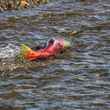
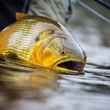
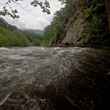


















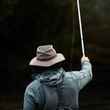
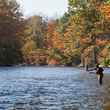

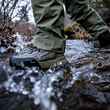



Comments
Ed Snyder replied on Permalink
Only issue I have, and I think a lot of locals have with the "sport" fishing is that more rainbows die from the catch and release then anyone taking two or three a day! Limit one is crazy when you watch 10 float past you due to catch and release!!
Jim Parks replied on Permalink
The Guad is not the southernmost trout stream in America. The Kokee State Park on the island of Kauai, Hawaii is further south by approximately 7 degrees of Latitude.
Jorge replied on Permalink
Sorry, but we fish trout in Hawai`i. Check your map, we're much further south !
Larry McCarver replied on Permalink
If you access the river near the small town of Sattler Texas at the Rio Guadalupe resort you’ll have your answer regarding the limited dry fly or top water bite. The head count of Osprey is high. Those fish foolish enough to venture into the shallows have a limited lifespan.
Pages